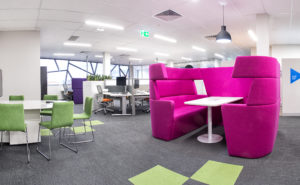Extroverts and Introverts: How to create an office for both
There is a lot of talk about designing and planning offices for millennials, but what about designing offices that provide for different personality types like extroverts and introverts?
How do you give employees control and choice over where and how they work? What work settings are available in your space to cater for the varied wants and needs of extroverts and introverts?
With intentional and considered workspace design throughout the office environment, businesses can successfully empower each of their employees without ignoring the needs of anyone. Both introverts and extroverts need workplaces with a range of spaces that allow them to choose what works best for them.
People who are introverted are focused more on internal thoughts, feelings and moods and are very aware of their environs and pay attention to the details around them, due to their observant nature. When introverts spend time in activities or environments that are very high energy and collaborative, they can end up feeling unfocused and overwhelmed. When designing for introverts, it is important to consider that they need their own space and prefer one-on-one conversations and small groups for collaborating.
A study published by British Psychology Society revealed that many features of the modern office were much more likely to be preferred by extroverts than by introverts. The author also explained that in this study “extroverts were significantly happier at work and had higher levels of job satisfaction.” The shift toward mobile and working agile has left introverted employees with limited options for concentrated work. Extroverts love high-energy workspaces and recharge by being around people. They are concerned with interacting with co-workers, therefore open spaces and group collaboration are perfect for them.
In a study by HBR, 98% of the most highly engaged employees reported that they had “the ability to concentrate easily” in their workplace and that this attribute is a top factor in their satisfaction. They also scored high on “being able to work in teams without being disrupted” and “being able to choose where to work according to the task at hand”. When designing office spaces, we need a range of spaces that are created for both group and individual work, some that are assigned and others shared.
It’s important to integrate spaces that encourage people to retire from their work tasks and to rest and revitalise. It’s important to provide work points that allow employees to feel physically connected with others, even when working alone. Often workspaces are designed with a bias toward collaboration and social connections, without providing adequate and varied spaces quiet and relaxation space for concentration and rejuvenation.

